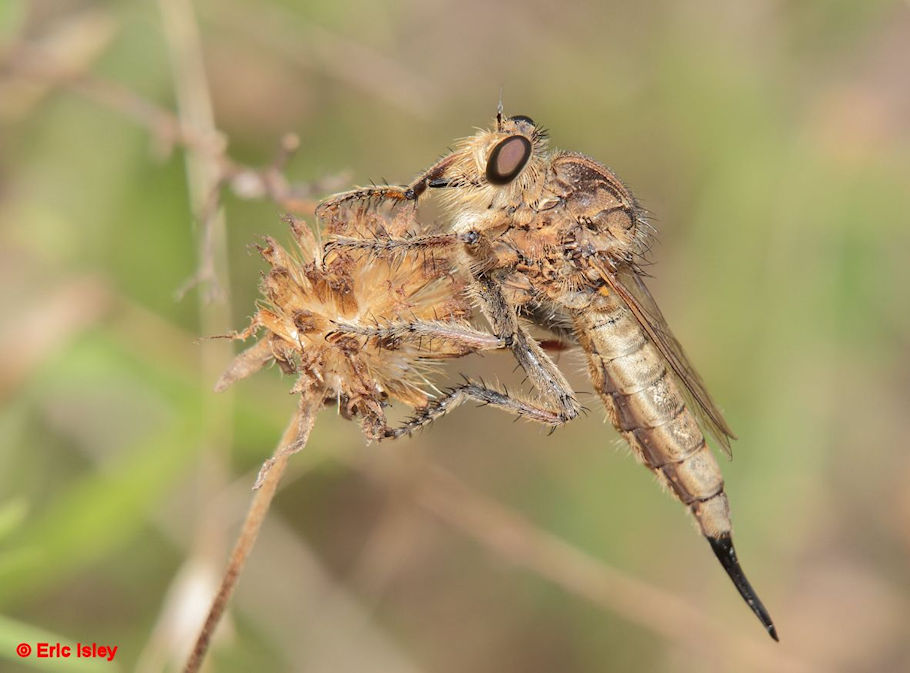|
|
|
The female E. nemoralis with her sword-like ovipositor. This sword is also seen on Efferia [Nerax] aestuans though [Nerax] females are much smaller. Swords are likely on the other Arkansas Pogoniefferia species. I will have to see this for myself. |
|
|
|
Paired Pogoniefferia in a tangle. Note the red tibias on both sexes and the ovipositor sword that seems to disappear. This is the Pogoniefferia that confused us for a bit in Arkansas that is closely related to P. nemoralis. This has now been cleared up and it is not a new species. It is, in fact, P. plena, previously known from Oklahoma, Kansas and Texas. It is apparently often mistaken in collections and likely is more common than listed in OK, AR, TX, KS. (See PROC. ENTOMOL. SOC. WASH. 109(1) 2007 208-222, Barnes). |
|
|
|
A slanted dorsal shot of the P. plena which shows the difference in the third abdominal segment. In this species it has a dark central square and sometimes on silvery hairs at all. In P. nemoralis this segment is mostly white with a small black central stripe or no black. |
|
|
|
The P. plena or possibly nemoralis species female becoming only the third species I have seen take adult dragons. |
|
|
|
P. plena female egglaying in a deadhead in a prairie area in Franklin county. |
|
|
|
Another P. plena female egglaying, this one inserting in a tall grass stem. She went up and down the stem several times. |
|
|
|
Female Efferia [Pogoniefferia] pogonias. I can now confirm they don't have a true sword ovipositor. They do have an elongate terminus but it is rounded and dark like a Proctacanthus female. That is a colorful leafhopper in feeding position showing that these females are generally smaller than E. nemoralis as well and are, in fact, very close in size with the female [Nerax]. |
|
|
|
Male E. pogonias. This is the fall form which seems smaller and darker to me than the spring emergence. They stay low to the ground and are very buzzy in dry open grassy areas in my region. Often dominant in these areas in September along with the Proctacanthus milberti. |
|
Another male E. pogonias. This also from Camp Robinson in the fall of 2005 which was a boom year for this species. The mystax looks so much paler here. And the wings look darker. Low fliers. They love the rockiest areas and the bordering grasses. |
|
|
|
Female E. pogonias are, as with most robbers, the more aggressive of the sexes. I couldn't decide if that was a Syrphid or a Tabanid this lady was puncturing. She looks almost black with her belly swelling from the fly blood |
|
|
|
E. pogonias again and this is another female from Petit Jean in the late summer. I thought it was an unusual kill to take an ant but closer inspection showed this was a winged ant. And this likely got it into trouble. I have never seen Efferia take ants from the ground. Dr. Eric Fisher knows of several ant feeders however. Including Ceratainiops and Dioctria. I don't believe we have an ant-eating specialist in my state or even the east. |
|
|
|
This is, I thought, another species in the Pogon group [Pogoniefferia] when I found it in the fall at Camp Robinson. I photographed it but did not capture it. It did not fit any of the known Arkansas species at the time. The markings resemble [Albibarbefferia] but I thought it was a Pogonid. I know now it is likely the first Efferia [Nerax] femoratus for the state. |
|
|
|
The other Efferia species in the southeast is this [Nerax] femoratus and it is known from Louisiana, Georgia and Florida. It may occur farther west but it is unknown. Note the strong resemblance of this E. femoratus from Florida taken by Steve Collins to the above robber shot of mine taken locally. It has similar legs and thorax. Note that it has segments 5, 6, 7 silvery and the above unknown Efferia has a rim of 4 white and then 5,6,7 silvery. One of the other possible [Nerax] species for Arkansas is Nerax kansensis but it has some yellow on the tibias which both of the above lack. [Albibarbiefferia] bicolor does not have three silver segments but has only 7 silvery. |
 |
|
The male from Central Texas from Eric that was difficult until he shot the females below. I believe now these are Efferia snowi in the Arida group of Efferia. Only three species in his area in that group so the wing veins on the female made it a bit easier. This group is difficult anyway. And I will replace this male shot with a better one when Eric tracks one down. For now it shows the four segments of white with some parted hairs on the forward silvery segment. And the golden yellow facial hair and mystax. We have records for this species in AR and it is our only Arida member in our state. |
 |
| The stunning female shot. And Eric had no coupling shots but this is almost certainly the female. In the same area and similar scutellum and thorax dorsum. He had another shot showing the full wing venation. This is a five star shot however. |